Back in April of 2019, I visited the city of Shanghai for the second time in four years. My first trip there, which I took with my dad in 2015, was an absolute blast. That trip really shaped my thoughts on authentic Chinese cuisine, and I left with a deeper appreciation of it. When I returned four years later, I found myself craving the foods I’d fallen in love with the first time, many of which are the best Chinese dishes you must eat in Shanghai.

Shanghai cuisine is one of the ten major cuisines in China. Even though it has existed for over 400 years, it is the youngest of the ten. Shanghai cuisine is known more for its rice-based dishes than ones with noodles. It includes salted meats, preserved vegetables, and seafood. The dishes are often red and shiny from being pickled in wine. Sweet and sour flavors are prominent, and special emphasis is often placed on condiments.
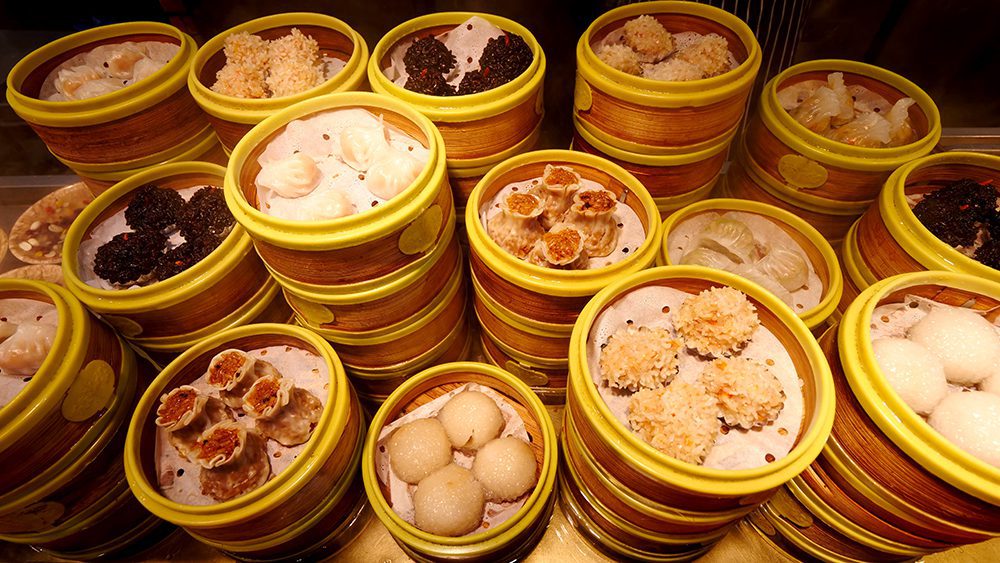
The unique mixture of flavors and textures in Shanghai cuisine make visiting the city a heavenly experience for any food enthusiast. Whether you’re into having street food on the go or enjoying a sit-down meal, chances are, the food will be divine. I dove even deeper into the city’s cuisine during my second trip and was blown away by what I found. These are the 25 Chinese dishes you must eat in Shanghai, China.
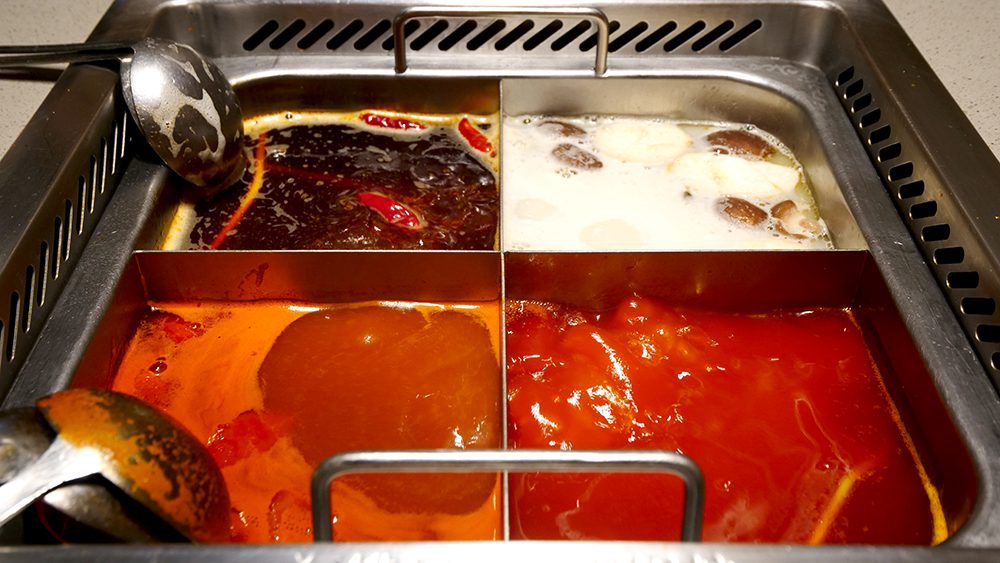
When you travel to Shanghai, eating hot pot is a must. One of the city’s best hot pot spots is Hai Di Lao, a Szechwan chain that has several locations around Shanghai. At Hai Di Lao, you will be provided with platters of raw foods like beef, pork, lamb, cabbage, and mushrooms. In the center of your table is the hot pot, which is divided into four sections. Each section contains a different soup. They range from mild to ultra spicy!

You cook your meats and vegetables in the soup of your choice for two minutes, let them cool, and then enjoy! I recommend cooking the beef and lamb in the moderately spicy soups, the cabbage in the tomato soup, and the mushrooms in the mildest soup. I love spicy foods, but the spiciest soup made me feel like I had set my tongue ablaze, so I mostly avoided it. Fiery soup aside, the hot pot at Hai Di Lao is one of the Chinese dishes you must eat in Shanghai, for sure!
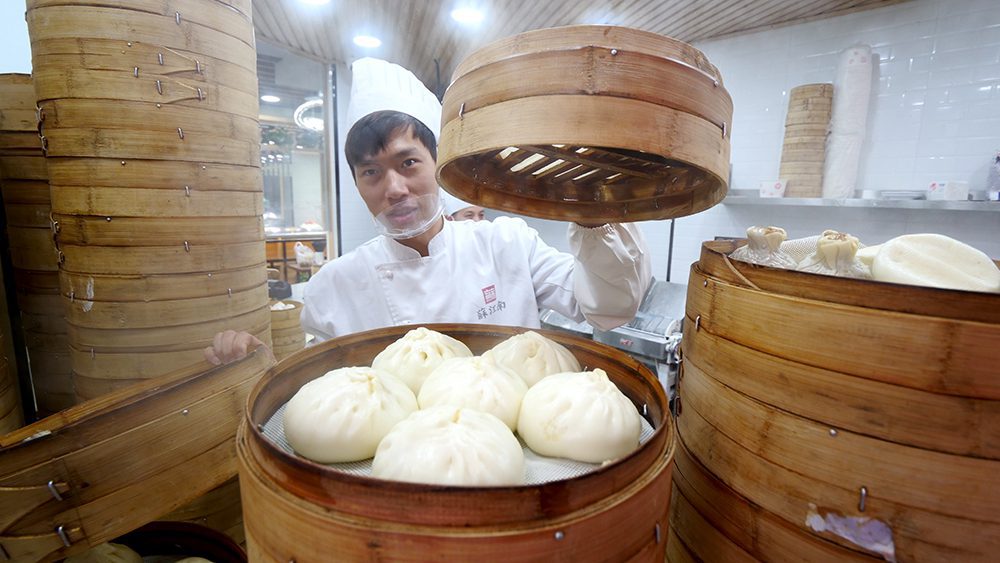
One of my all-time favorite things to eat in China is char siu bao, or the pork bun. During my first trip to the country, I ate one almost every morning. When I returned to Shanghai, I knew I had to find this fluffy, divine morsel again. I found it on my first morning in the city at a hole-in-the-wall street food spot that sells about 20 types of bun along Huanghe Road. The pork buns are pillowy and fluffy on the outside, with lots of sweet, juicy, and spicy pork and sauce inside. The flavor and texture combinations are unbeatable!

The same stall that sells the variety of buns also offers dumplings, including some varieties I had never seen before. One of them is a sticky-brown-rice-and-herb dumpling that was very different from any other dumpling I’d ever eaten. It’s very tasty, with lots of herbal flavor. I also really enjoyed the sticky rice inside. It’s definitely a must-have when you visit Huanghe Road!

When I think of the top Chinese dishes you must eat in Shanghai, only one comes to mind: the mouthwatering pancake-like dish I fell in love with along Huanghe Road back in 2015. It’s called jianbing and quickly became my favorite Chinese street food after a single bite. After a bit of searching along Huanghe Road, I found it in a tiny shop just off the street.

Jianbing is a folded crepe that contains eggs, crackers, pickled vegetables, and hoisin sauce. It has a sweet and savory flavor and the crackers inside give it a nice crunch. The egg inside is a little runny and is delicious with the hoisin sauce. It almost reminded me of an Indian dosa, only with Chinese flavors! This dish truly makes my taste buds go haywire every time I eat it. The only thing is, the shop that sells it only offers it until 11 a.m., so head down to Huanghe Road early if you want to have one!
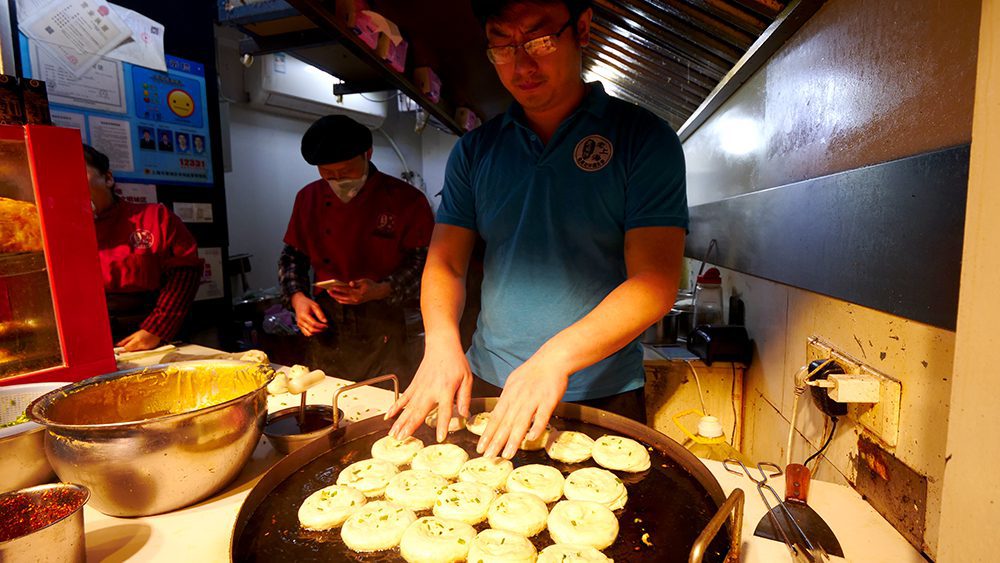
Almost directly across the street from the tiny shop selling the jianbing is another Chinese-style pancake. This one isn’t a crepe—it looks more similar to pancakes in America, except it’s super crispy and is filled with delicious, green scallions.

These pancakes are pan-fried and then baked afterward, which gives them their crisp exterior and soft and moist center. They contain an overload of scallion flavor and, like the jianbing, make for a quick and easy breakfast when you’re on the go. If you’d like, try the other varieties of pancake, like the chive-and-egg pancakes and leek-and-egg pancakes. Go nuts and see which one you like the best!
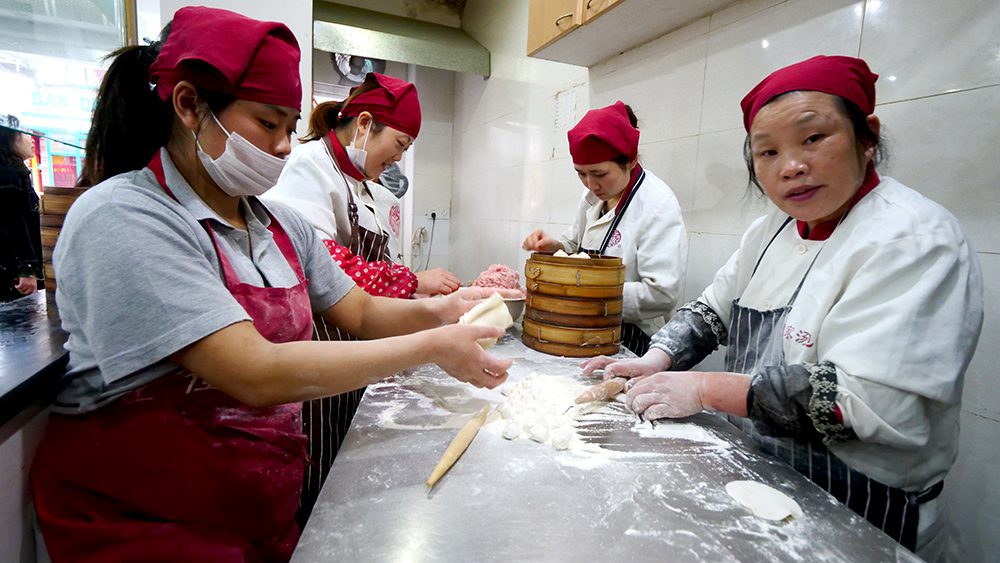
One of the most popular spots along Huanghe Road is Jia Jia Tang Bao, a sit-down restaurant that is easily recognizable from its white storefront and large, red Chinese characters above it. I’m convinced some of the tastiest Chinese dishes you must eat in Shanghai are their shrimp dumplings and pork dumplings. Order them with some egg drop soup for a fantastic flavor combination!
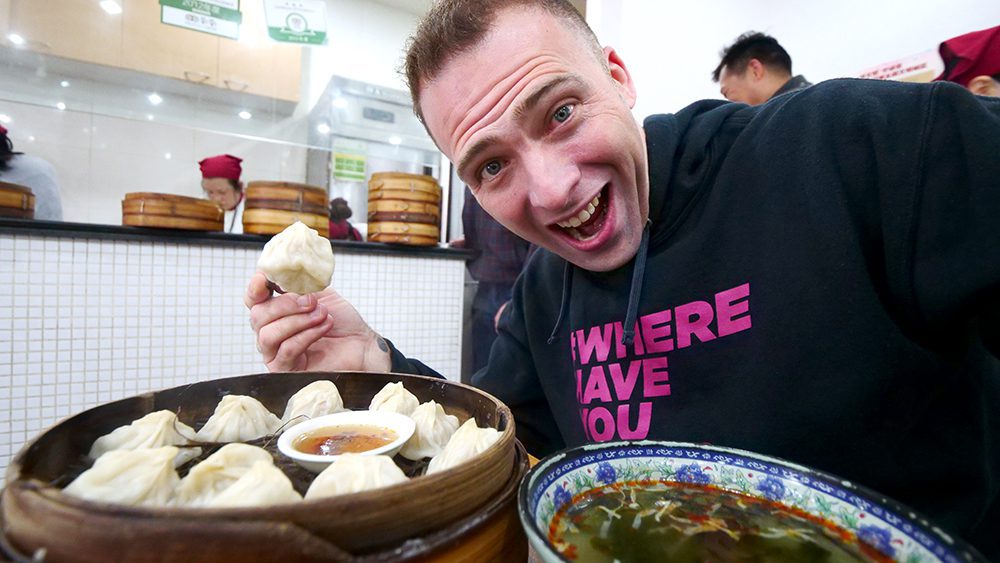
The soup is flavorful and aromatic, with big pieces of briny seaweed. I loved the freshness of the dumplings, which are soupy inside. They are sensational when you dip them in soy sauce. Of the two varieties, I preferred the shrimp. You get six of each per order, so 12 in total. The soup and the 12 dumplings will only set you back about $4 USD, so eating it is a filling and inexpensive way to start your day!

Shanghai Tower is among the most popular tourist attractions in Shanghai for its observation deck, which offers unbelievable views of Pudong and the surrounding city. But it’s also worth visiting because of its Food Republic food court near the observation deck’s exit. There, look for an eatery called Hok Kee and order their beef noodles with eggs, herbs, and sprouts.

The noodles are served in a dark, rich, and earthy sauce that pairs extremely well with the crunchy, refreshing vegetables. The noodles are hearty and thick and do a great job of holding onto the sauce. The dish doesn’t contain a lot of beef, but it’s so tasty that I didn’t really miss it. Try this dish for only 35 Yuan, which translates to a little over $5 USD. It’s another inexpensive and tasty Chinese dish you must eat in Shanghai!
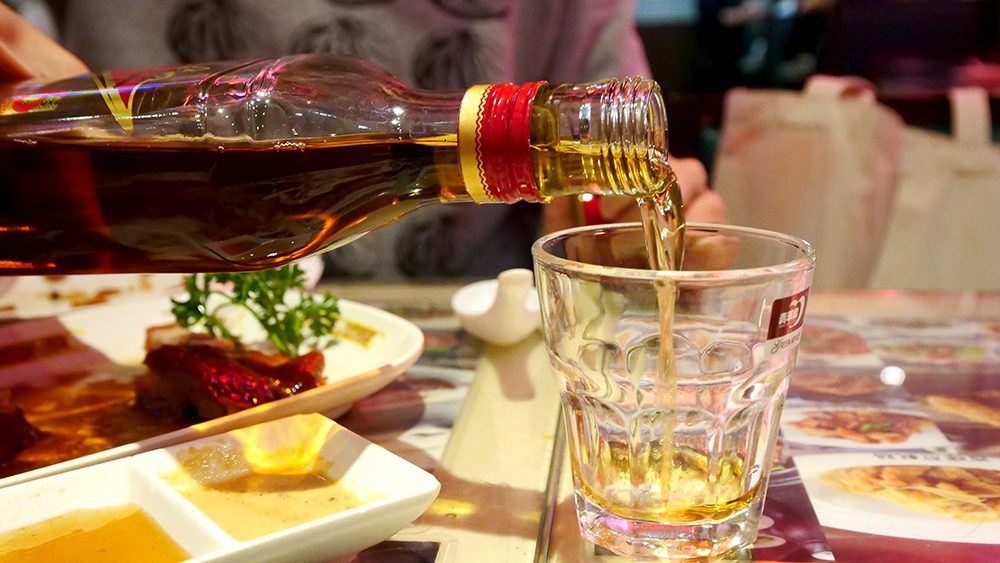
One of the best things any foodie can do in Shanghai is book a food tour with UnTour Food Tours. They offer fantastic food tours in multiple Chinese cities, including Beijing, Chengdu, and Hong Kong. During their multi-regional Shanghai Night Eats Tour, you can try dishes and beverages from all over China, including the Golden Age yellow rice wine at the Cantonese, Hong Kong-style café.
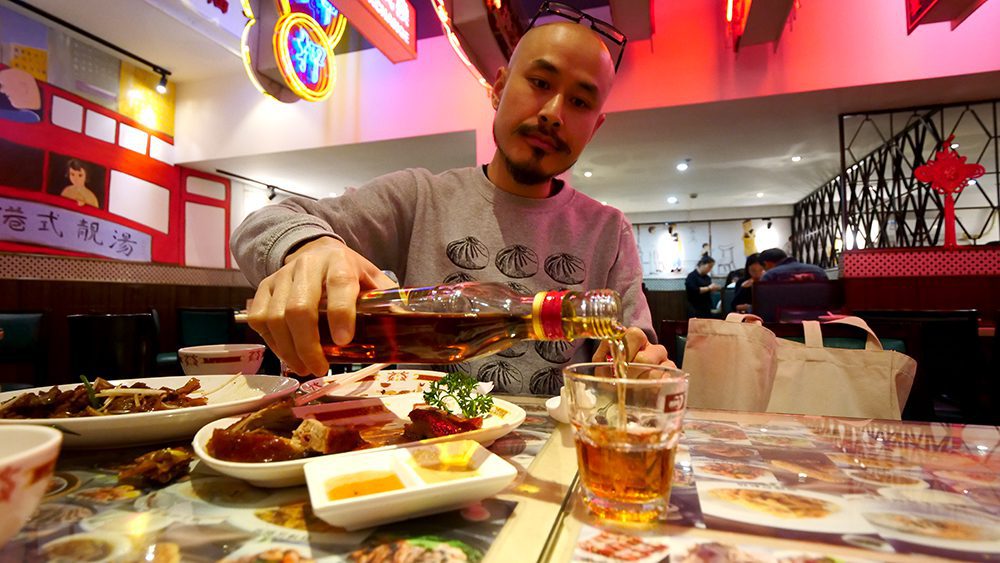
As a wine lover, this rice wine was one of the highlights of my multi-regional food tour. It reminded me a lot of sake and had a nice, plum-like flavor that paired well with the roasted pork, roasted duck, and rice noodles with beef I also enjoyed there. This is one rice wine you can’t afford to miss!
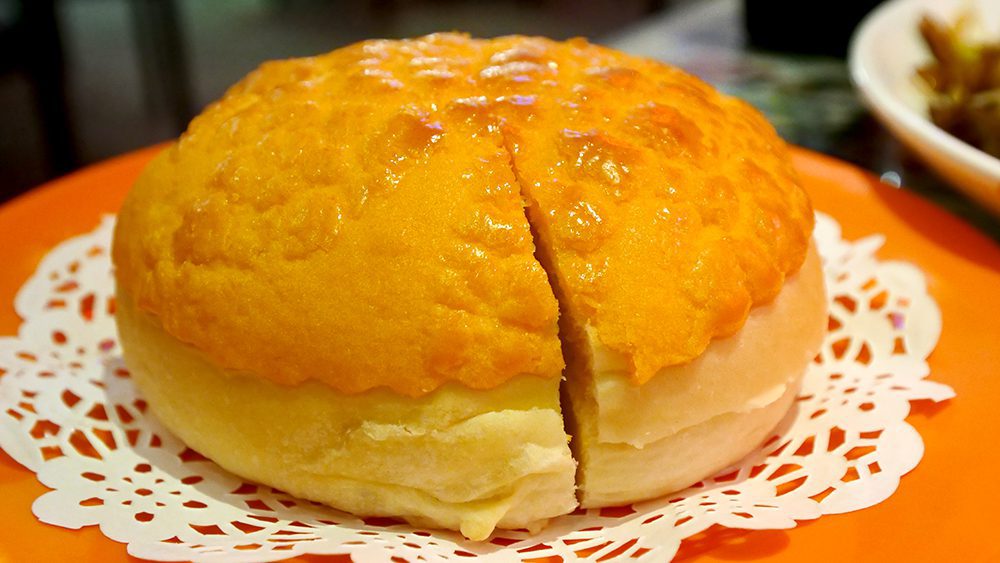
Another Cantonese specialty you must try on UnTour Food Tours’ Shanghai Night Eats Tour is the pineapple bun at the Hong Kong-style café. It’s easily one of the top Chinese dishes you must eat in Shanghai. The food in Hong Kong has been influenced by other people, namely the British, who occupied the territory from 1843 to 1941 and again from 1945 to 1997.
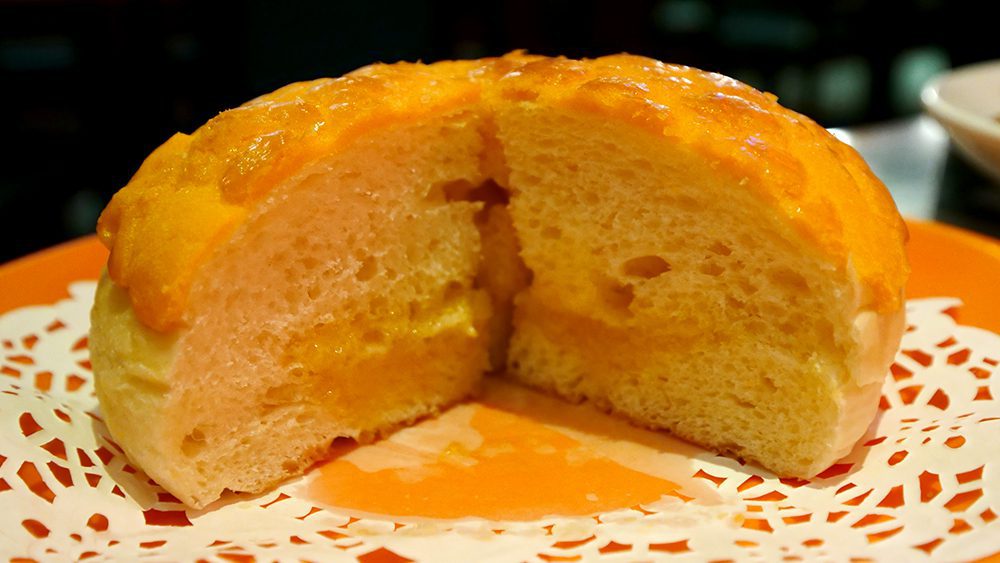
The British influence can be seen in the pineapple bun, which is an early adaptation of the British influence on Hong Kong’s bread. Its name is a little misleading, as it doesn’t contain any pineapple, but it does have a thick crust and is filled a nice layer of butter! It’s also extremely sweet, so it’s more like a dessert.
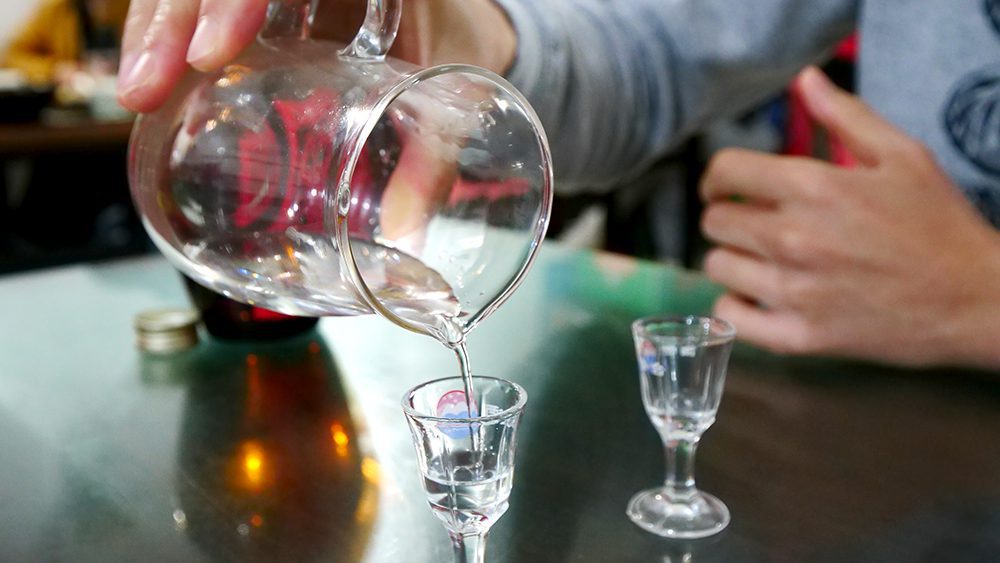
If you like alcoholic beverages, you can’t visit China without having some baijiu. Baijiu is a fermented drink that has an alcohol content level of between 28% and 65%. There’s a type of baijiu that you’ll try on your Shanghai Night Eats food tour that is basically China’s version of moonshine. Its name translates to Confucius’ House Wine.
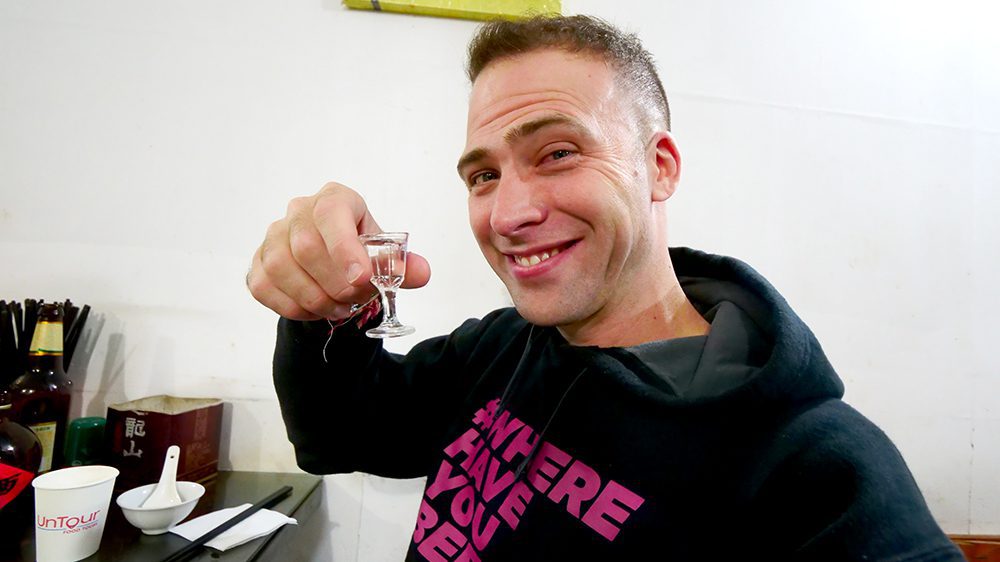
I tried the “Strong Aroma” version of this spirit at a spot that sells Ningbo food. My friend and guide, Li, explained to me that this type of baijiu is the most-consumed hard liquor in the world. This particular type was about 39% alcohol, which puts it on the weaker end of the baijiu scale. That said, it was so strong that I could smell it as soon as the bottle was opened, and it was downright brutal to get down! It was good, though, and made me want more!
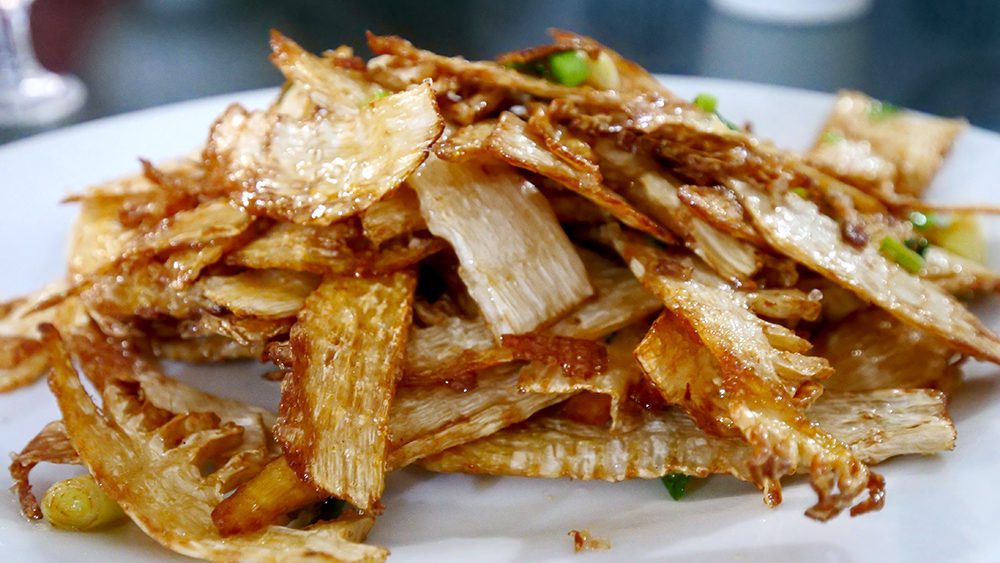
When I travel to Asia, one of my favorite things to eat is bamboo. I’ve tried it in multiple Asian countries in various dishes and it never disappoints. One of my favorite bamboo dishes is a fried version I tried at the Ningbo restaurant on my Shanghai Night Eats food tour.
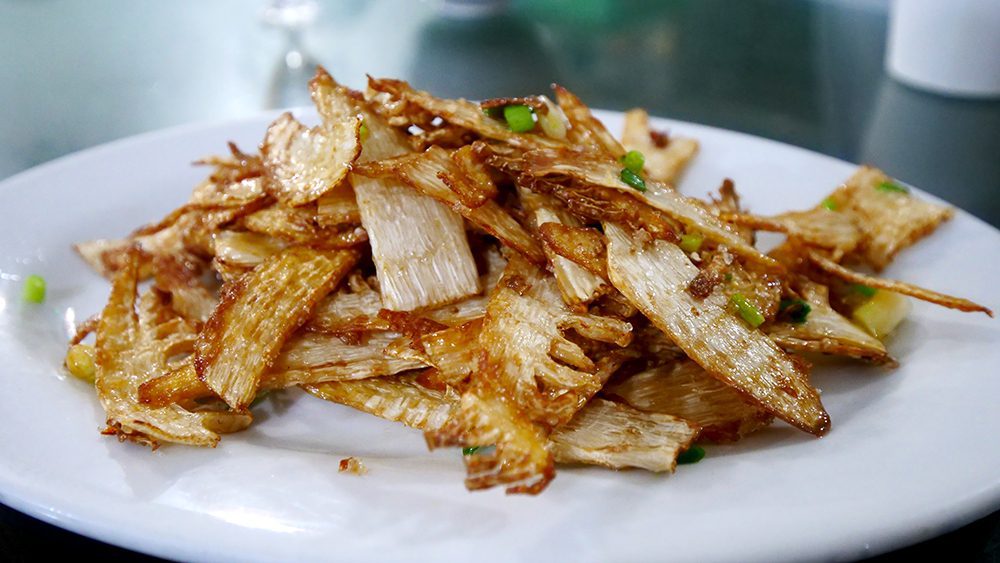
This bamboo was extremely crispy on the outside but moist in the center. The dish kind of reminded me of crispy, fried onions and was very tasty. This is one of my favorite Chinese dishes you must eat in Shanghai, without question!
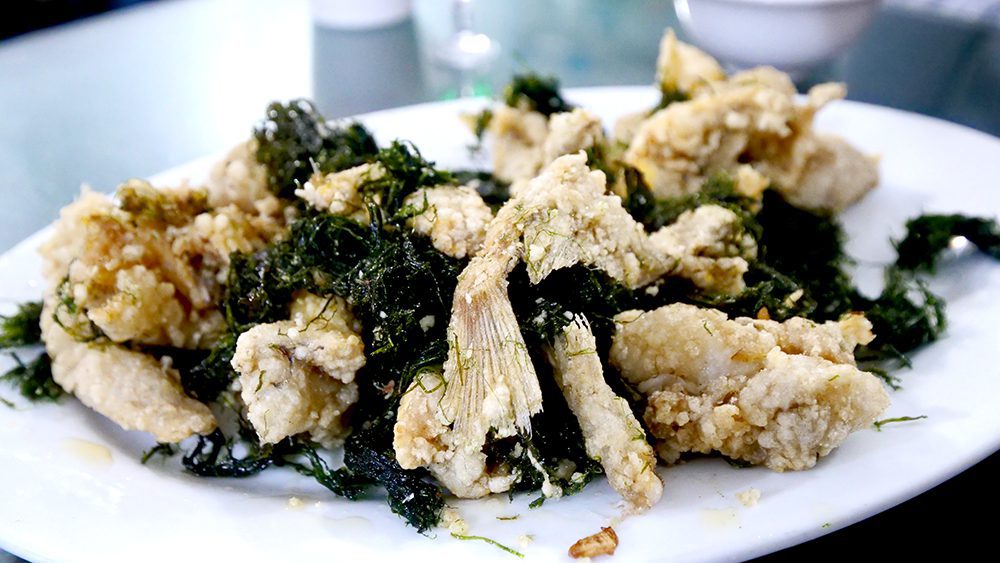
Continuing on with the fried and crispy theme, the next Chinese dish you must eat in Shanghai is a fried fish and seaweed combination. I also had this dish at the Ningbo restaurant my guide Li and I visited during my Shanghai Night Eats tour.
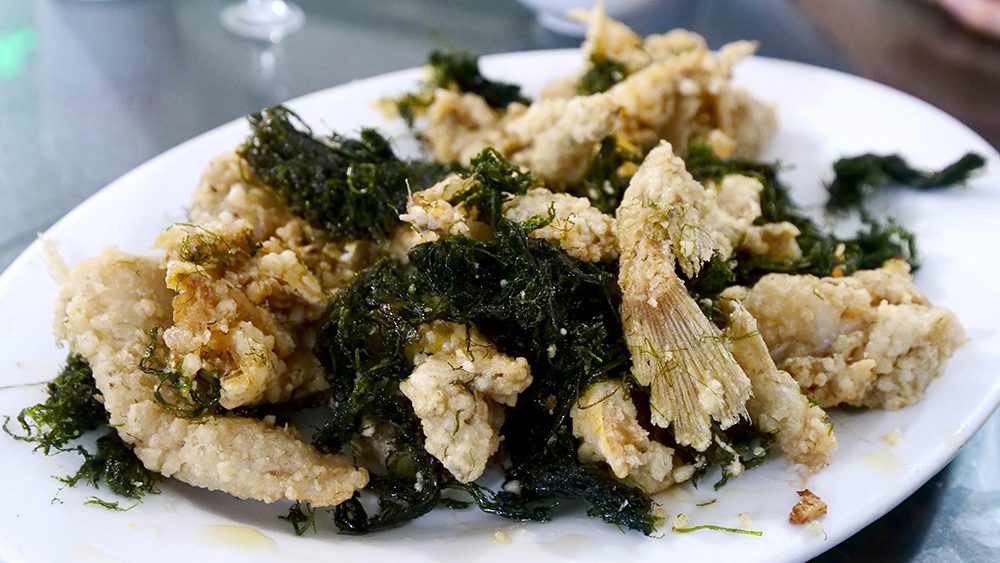
It’s a bony, saltwater fish, so be sure to chew them as well as you can so you can either break down the bones in your mouth or spit them out. The fish is meant to be eaten with the seaweed, which is salty and briny and practically melts in your mouth. It’s a must-try for sure but remember to look out for the bones!
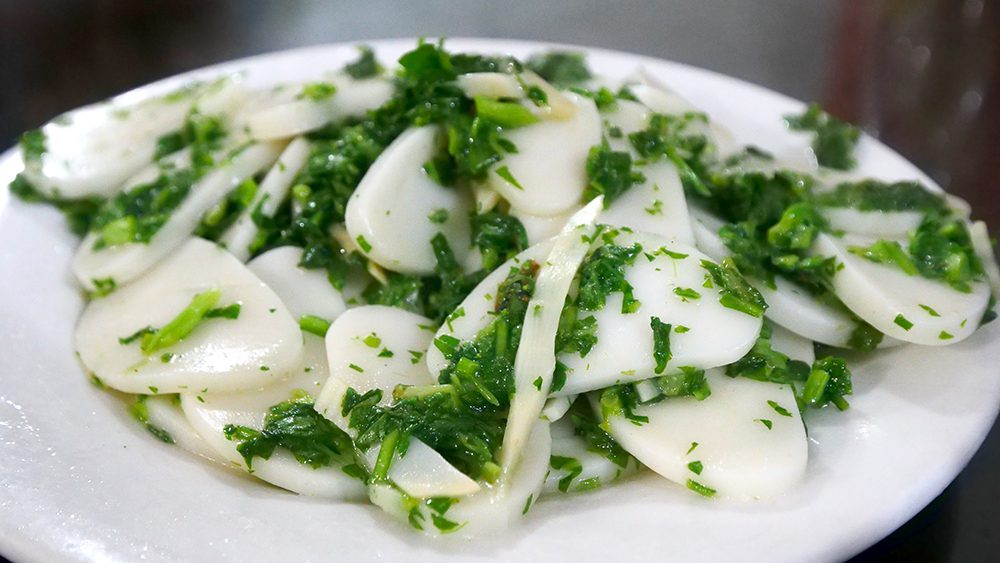
Another dish I love eating when I visit Asian countries are sticky rice cakes. I fell in love with the sweet versions in Japan and later discovered the savory and spicy varieties in South Korea. I also tried one at the Ningbo restaurant on my Shanghai Night Eats tour.
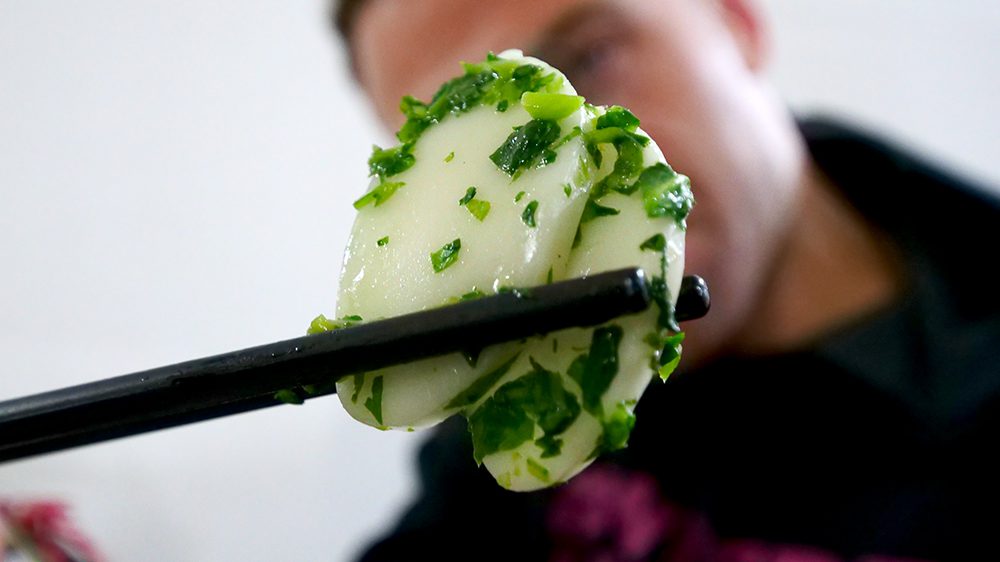
This dish consisted of a plate of sticky rice cakes that were stir-fried with bamboo shoots and an herb called shepherd’s purse. The mix of vegetables was so flavorful and unique. It was unlike anything I had ever eaten and was among the highlights of my tour. It’s the type of dish that would be great with some hot sauce!

The third spot I visited on my Shanghai Night Eats food tour was Chili Chill, a Sichuan restaurant with some exotic menu items. Sichuan cuisine is known for its spice, which you can smell even before you enter the restaurant! The most exotic dish I had there was easily the Sichuan rabbit head, which was first created in the 1980s.
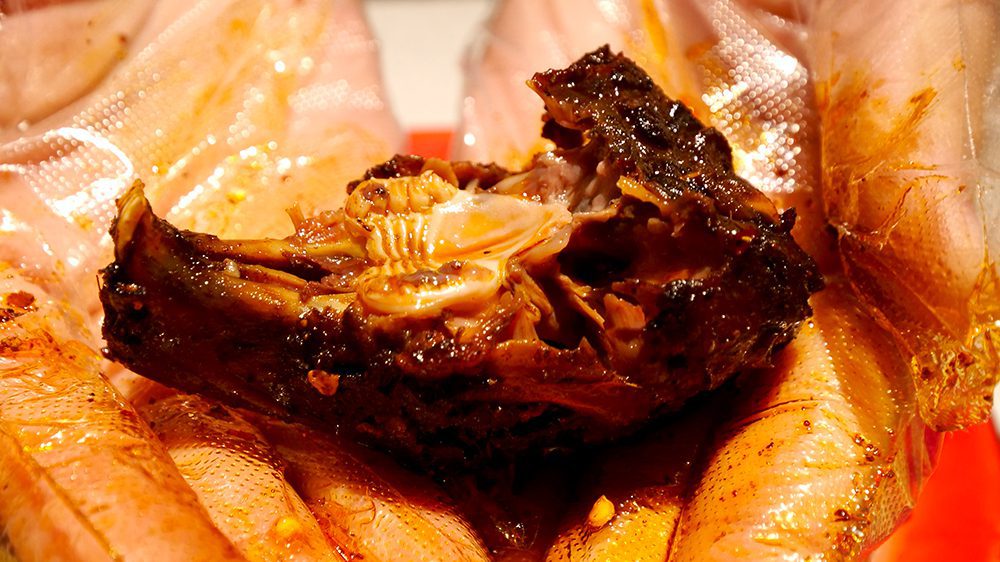
The whole rabbit head is cooked in hot chili oil with Sichuan peppercorns. It’s typically served cold, but mine was freshly cooked, so it still had some warmth to it. This dish is messy, so you’re given plastic gloves to handle it. You eat it by prying the jaws apart and eating the tongue and then breaking it further to get to the brain, and then eating the eyes and the rest of the meat.

It’s a little crunchy and is definitely hot, but the spice isn’t too extreme. It does numb your lips and tongue, but it’s worth it because it’s so ridiculously tasty. The eyes, in particular, were a flavor explosion in my mouth. I wanted more of them! The rabbit head may be a bit too extreme for some, but it’s still among the best Chinese dishes you must eat in Shanghai. Trust me!

You also cannot miss the Sichuan wontons at Chili Chill on your Shanghai Night Eats food tour. They’re served in a rich, red soup that gives off the impression of extreme heat. The wontons contain pork and ginger, as well as Sichuan peppercorn.

The wontons are so delicate that they fall apart the moment you try to pick one up with your chopsticks! They definitely have some heat to them, but they’re nowhere near as fiery as the rabbit head. It’s much more manageable if you’re not a big spice lover!
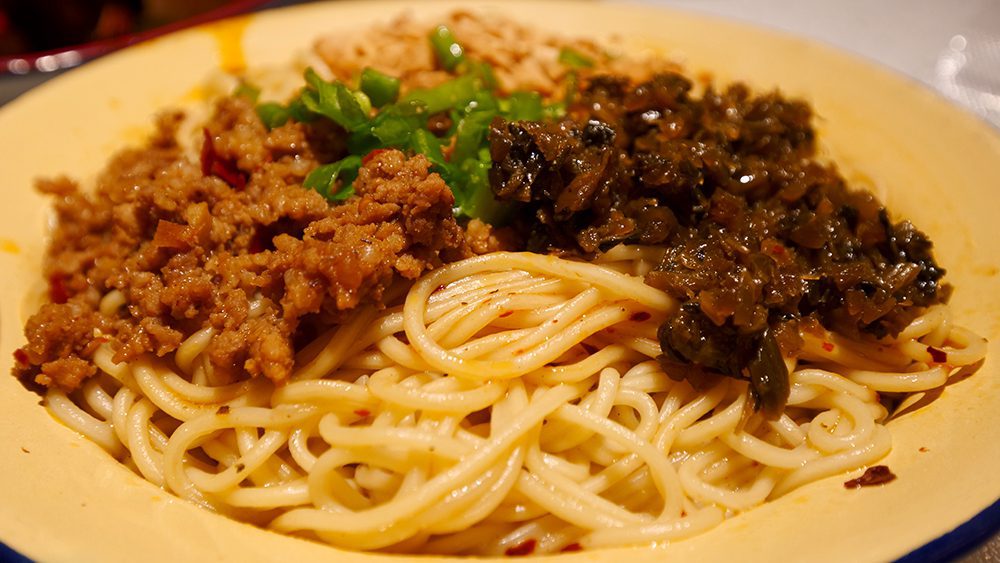
Another of my favorite Chinese dishes you must eat in Shanghai is the Sichuan dry noodles at Chili Chill. These noodles, which you’ll also find on your Shanghai Night Eats food tour, have a Sichuan name that translates to “burning noodles.”
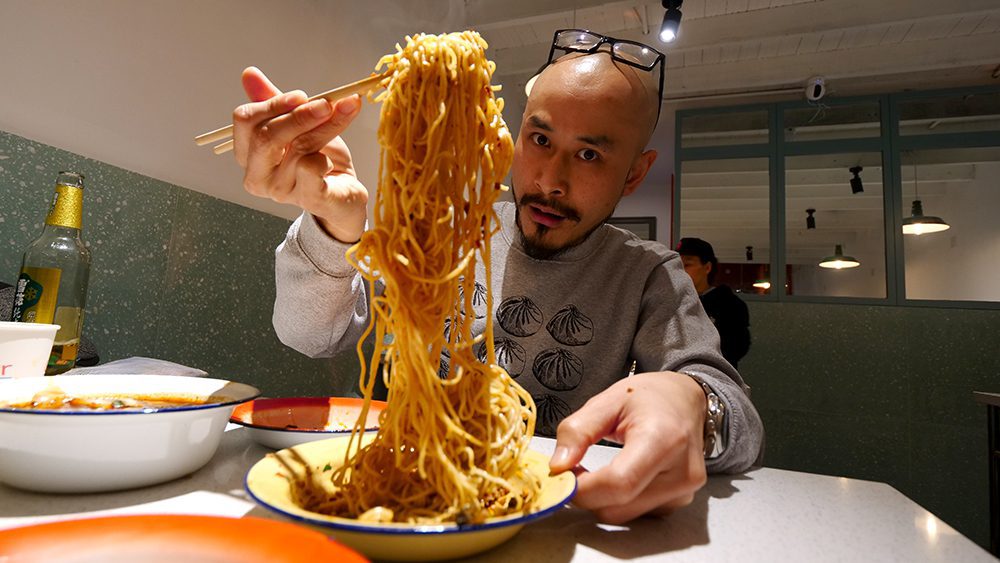
They contain peanuts, pickled vegetables, green onions, and minced pork. There’s quite a bit of hot chili oil on the bottom, so mix the noodles thoroughly before you dig in! These noodles reminded me a lot of the dry ramen I had during my time in Tokyo earlier in 2019. Like the wontons, there’s enough spice to make your lips tingle, but it’s not overbearingly hot.
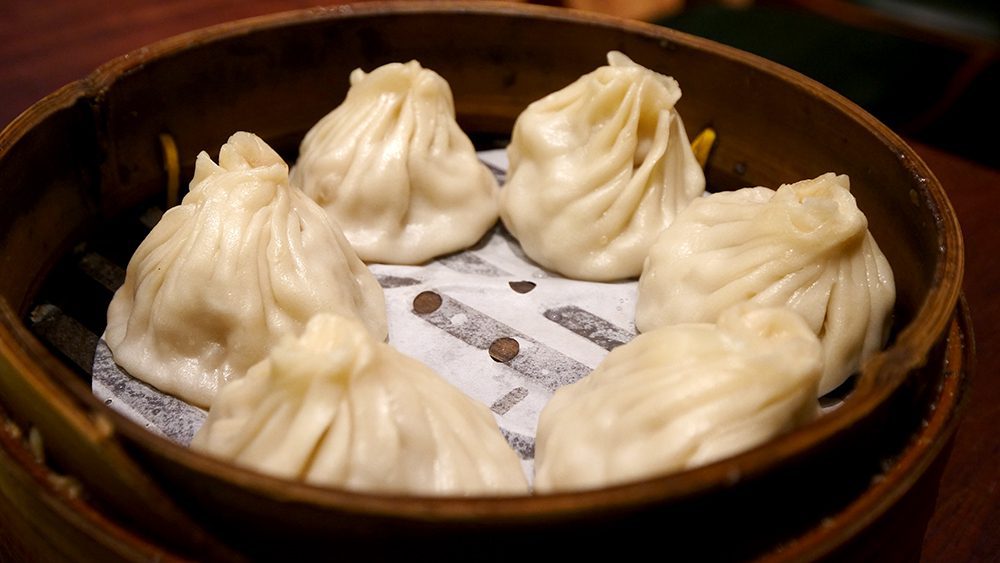
When you visit Shanghai, you have to try a xiaolongbao at the Shangxi restaurant on the Shanghai Night Eats tour. It is one of the ultimate Chinese dishes you must eat in Shanghai. Xiaolongbao is essentially a pork soup dumpling. Because there’s hot soup inside, you don’t want to burn your mouth.
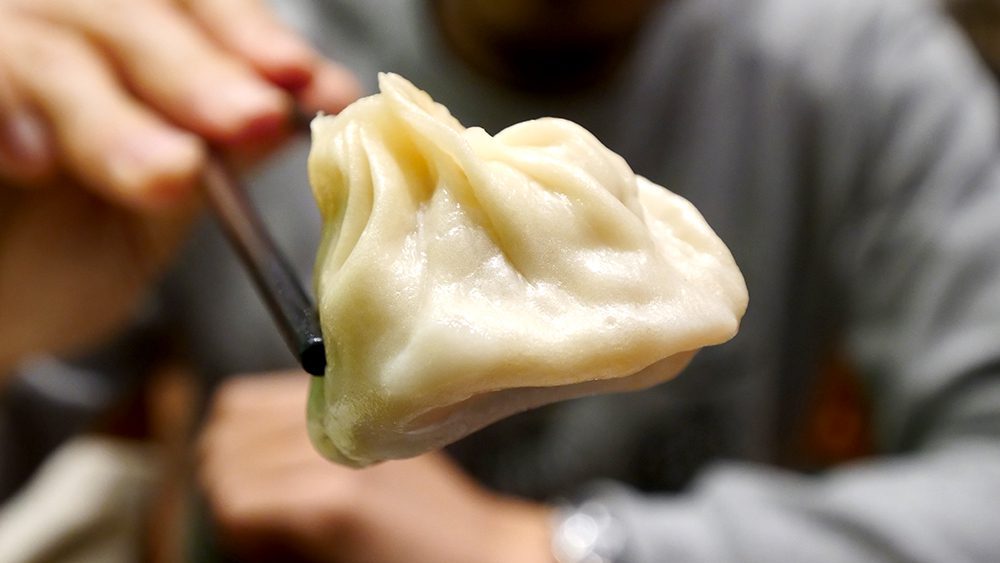
Luckily, there’s a trick to eating them without getting burned. Simply nibble a hole in a corner of the dumpling and slurp the soup out to mix as much air with it as possible to cool it down. Once you’ve slurped out the soup, dip the dumpling into your vinegar or sauce and eat it in one bite!

There’s a second type of xiaolongbao you can find in Shanghai, which is the original! You’ll find this version in the Old Town of Shanghai near City God Temple. These xiaolongbao are much bigger than the regular xiaolongbao. You have to pop them with a straw to drink the soup inside! They’re also extremely tasty and chewy and contain big chunks of pork and crab inside!
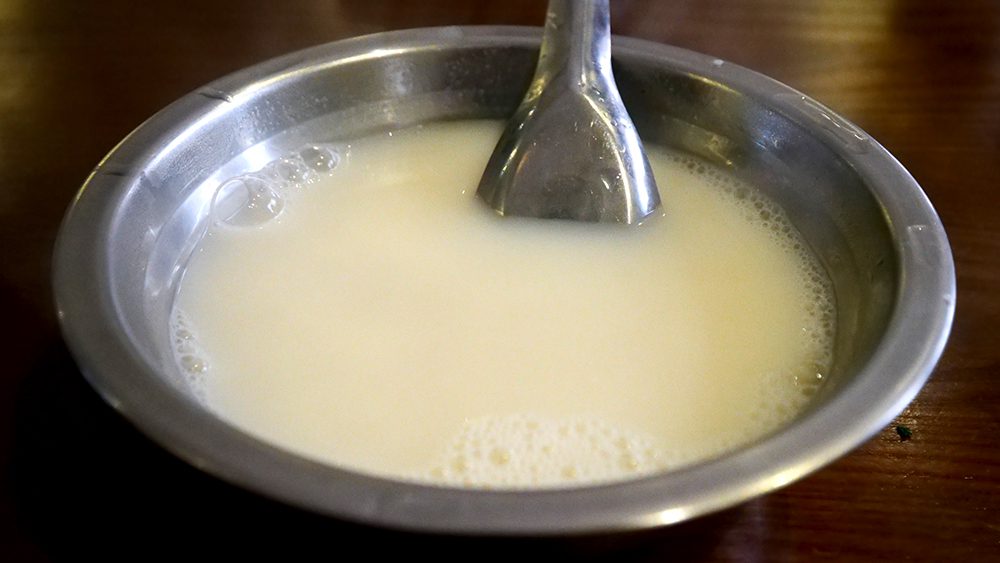
During my trip to China, one dish I tried a few times for breakfast is a chewy, airy, fried breadstick called youtiao, which comes with piping hot soymilk. It’s basically the Chinese version of a churro, except it isn’t coated in sugar. The first time I had this dish was on UnTour Food Tours’ Shanghai Street Eats Breakfast tour of the former French Concession.

The youtiao is pretty oily and can be eaten in two ways. You can either dip it into the soymilk, or you can tear it into small pieces and float them in the soymilk like cereal. I tried it both ways and they’re both fantastic! The youtiao tastes exactly like the churros I had in Spain, minus the sugar, of course. It’s a great way to start a day of exploring in Shanghai!

If you’ve never had a savory pancake, Shanghai is one of the best places in the world to try one. As you continue on UnTour Food Tours’ Shanghai Eats Breakfast tour, you’ll find a tiny hole-in-the-wall shop selling the thousand-layer pancake. There aren’t actually a thousand layers, only seven. It comes slathered in a delectable red sweet chili sauce.

Visually, it reminded me of a similar-looking dish I’d had in Greece. The pancake is flaky and delicious, with a crisp exterior and a soft center. The moneymaker is the sweet chili sauce, which is rich and full of flavor. It’s also deceptively spicy; the heat sneaks up on you after a few bites!
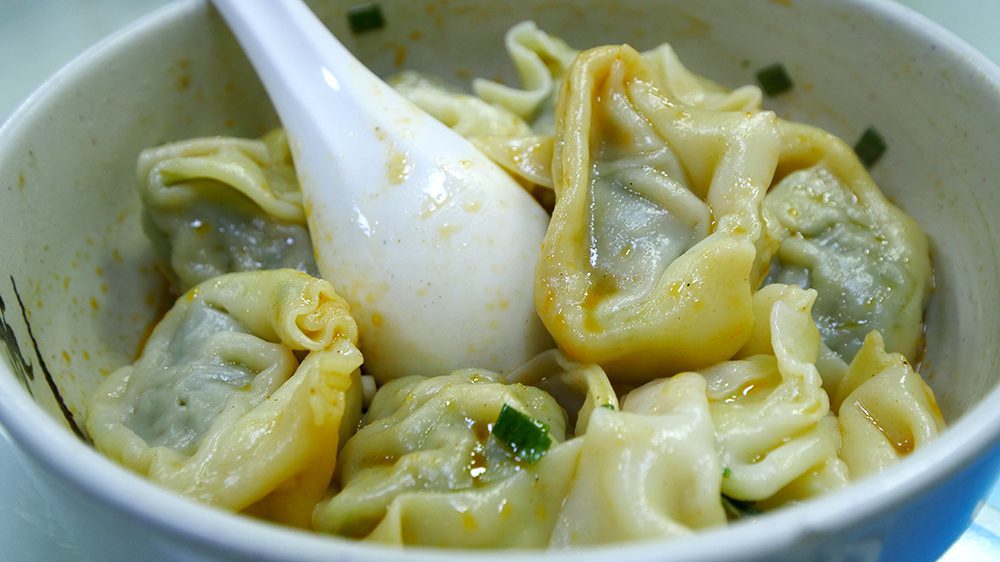
As you continue through the former French Concession on your Shanghai Eats Breakfast tour, Li will take you to a small eatery. There, you’ll be able to try some incredible wontons that are stuffed with pork and shepherd’s purse. They’re served coated in a sauce, but there’s no soup.

The filling of these wontons is out of this world! The combination of the pork and the shepherd’s purse is so flavorful. There’s also some spring onion sprinkled on the outside along with the sauce, which adds to the depth of flavor. The best part is, the wontons are very juicy, which gives them even more flavor!
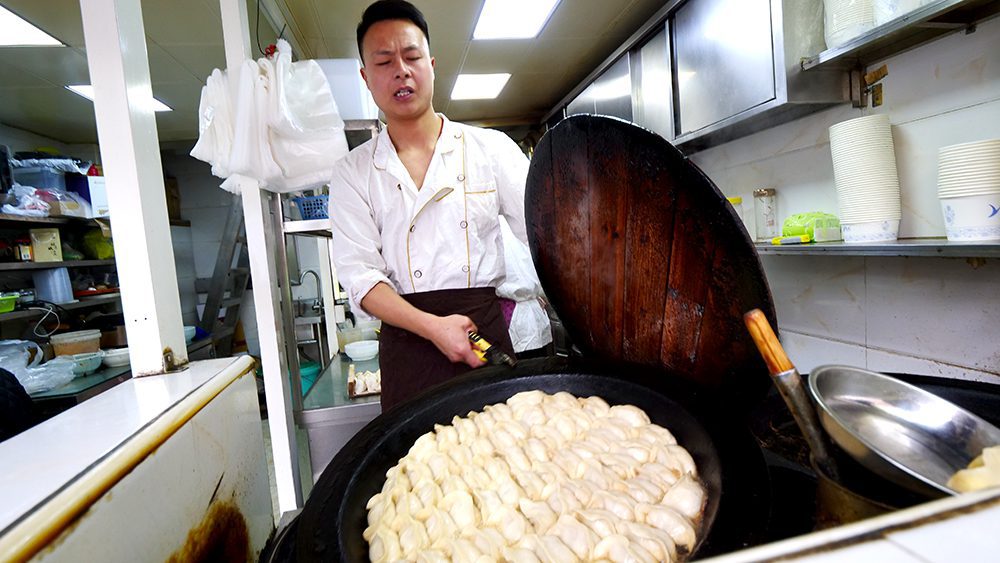
Don’t leave the tiny, hole-in-the-wall eatery after you try the pork and shepherd’s purse wontons. You’ll want to stick around and have some of their unreal soup pot stickers. These pot stickers are crispy on the bottom and also have a bit of sesame oil inside them.
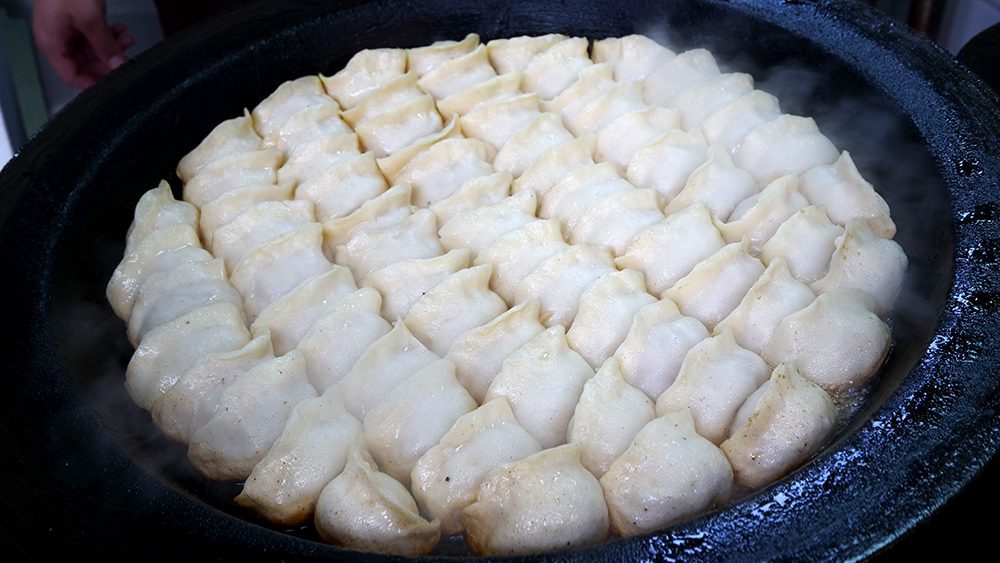
Like the xiaolongbao, it’s dangerous to bite directly into these pot stickers because of the boiling hot soup inside. Instead, treat them like a xiaolongbao and bite a hole in the top and slurp out the soup. Afterward, you can dip them in sauce or add some red chili flakes like I did!

Toward the end of my Shanghai Eats Breakfast food tour, Li took me to a noodle shop that’s open 24-7 every day except on the Chinese New Year. The shop has large, red, white, and yellow signs and Chinese characters above its door and makes Hunnan-style food. I recommend their super thin, hand-pulled noodles, which are served with a sticky sauce!
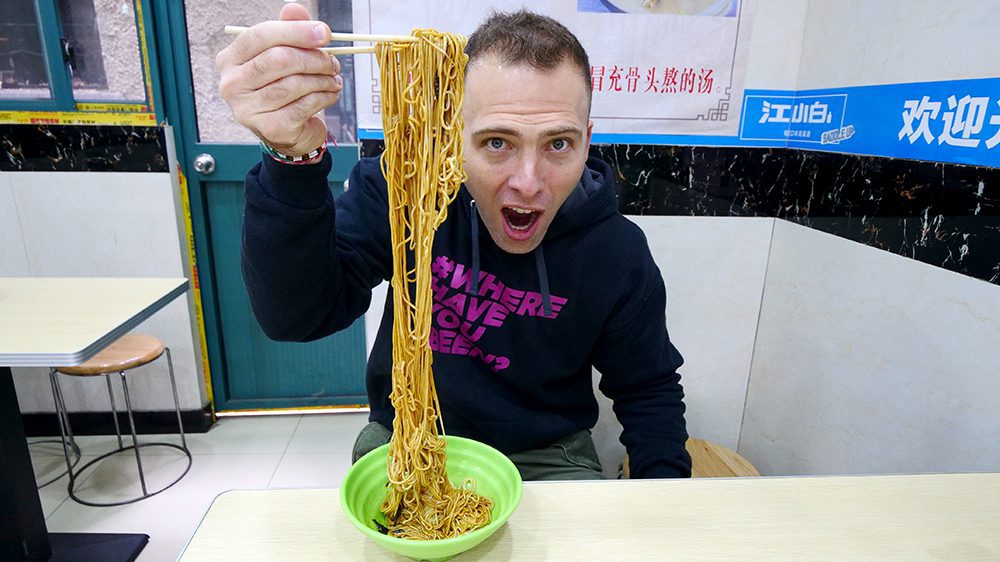
The noodles and sauce don’t have a ton of flavor in them by themselves, so I recommend adding some red chili sauce to give it an extra kick of heat and flavor. It adds a pungent flavor and just the right amount of spice and completely changes the dish. They’re some of the best noodles I’ve ever had and are easily one of the top Chinese dishes you must have in Shanghai!

Another fantastic tour company I recommend hiring for a food tour is Newman Tours. Their managing director, Daniel, took me on an unforgettable tour of the City God Temple and Yu Gardens area, where I tried a wild-looking and incredibly tasty deep-fried local crab! It’s literally a whole, deep-fried crab on a stick!

There are salty and spicy varieties, and being a spice fanatic, I had to go with the spicy one. It’s delicious and crispy and everything on it is edible. The best part about it is how meaty it is, especially in the middle. The crab meat is tender and succulent and had me in seafood heaven. It also has a nice amount of spice to it and is easily one of the best Chinese dishes you must eat in Shanghai!
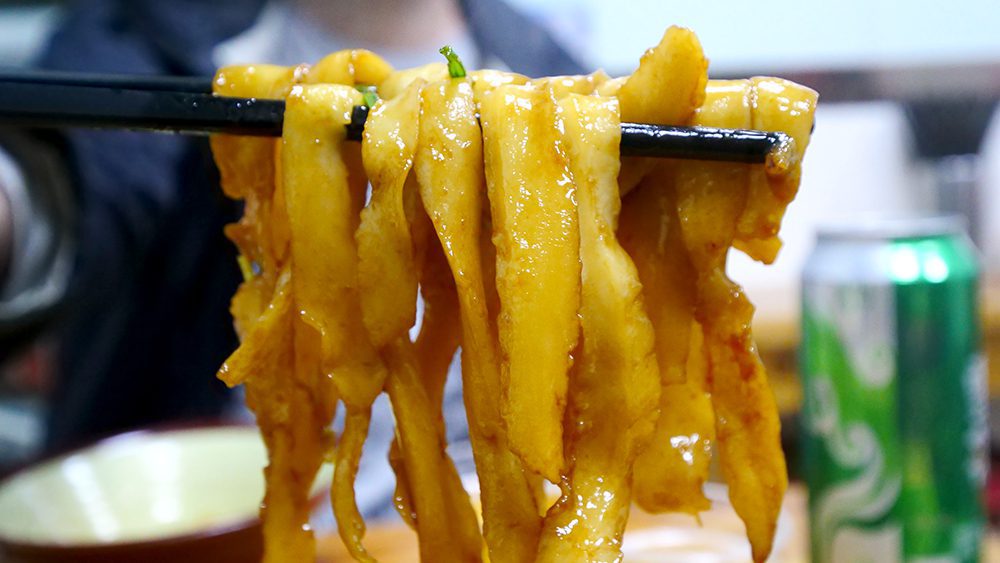
While UnTour Food Tours’ Shanghai Beer & Bites tour is more about the beers than the bites, you’ll still try some extraordinary dishes during your three-hour excursion. My favorite of the night was easily the knife-cut beef noodles, which contain cilantro and are served in a fantastic sauce. This Chinese dish you must eat in Shanghai is a can’t-miss!

These noodles are made from a dense, high-gluten dough and only take 30 seconds to boil. Because of the quick boiling time, they come out perfectly al dente. They’re cut very thick, so they hold on to all the unique flavors in the sauce. I added some spice to mine for an extra kick of heat. The spice along with the beef, cilantro, and al dente noodles was a combination that had my mouth watering with every bite!
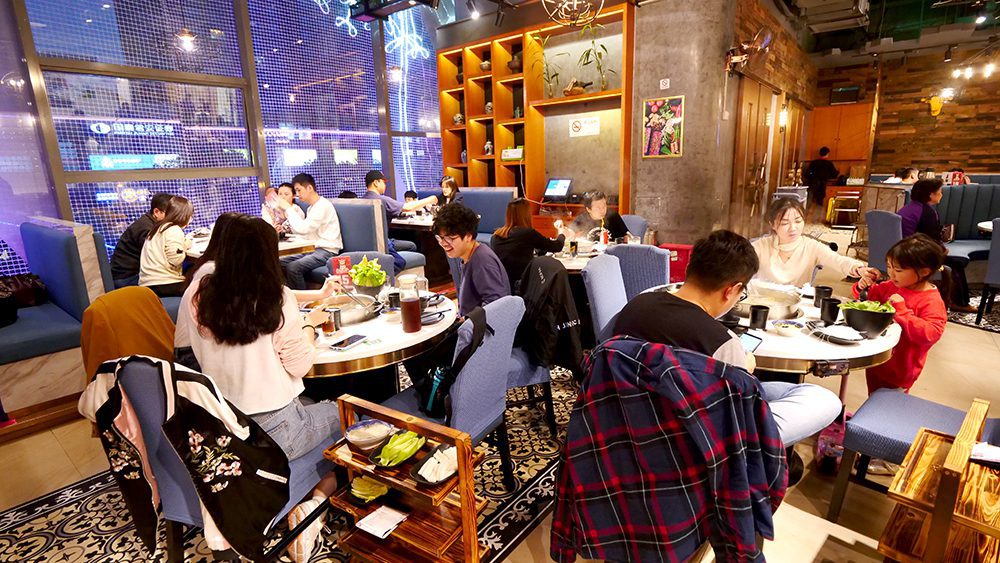
Hands down, one of the best restaurants to have hot pot in Shanghai is The Holy Cow Restaurant, which you’ll find at Bingo Mall. At this Chaozhou restaurant, you’ll quickly learn that they use practically the entire animal on their menu, including the internal organs. To complement the various meats, they even have a station where you can build your own sauce using various ingredients.

My hot pot spread consisted of 14 items, including meatballs, raw vegetables, dumplings, and lots of different cuts of meat. Like at Hai Di Lao, you cook whatever you want in the sauce or soup of your choice for a few minutes. I couldn’t get enough of the beef (which I cooked in a spicy, red sauce), the beef dumplings, and the beef shoulder.

The gelatin-like cow stomach, golden needle mushrooms, and tofu skin were equally unreal! The real star was the free-range venison from New Zealand. It had a rich, earthy taste because of its high iron content. The venison alone is among the Chinese dishes you must eat in Shanghai!
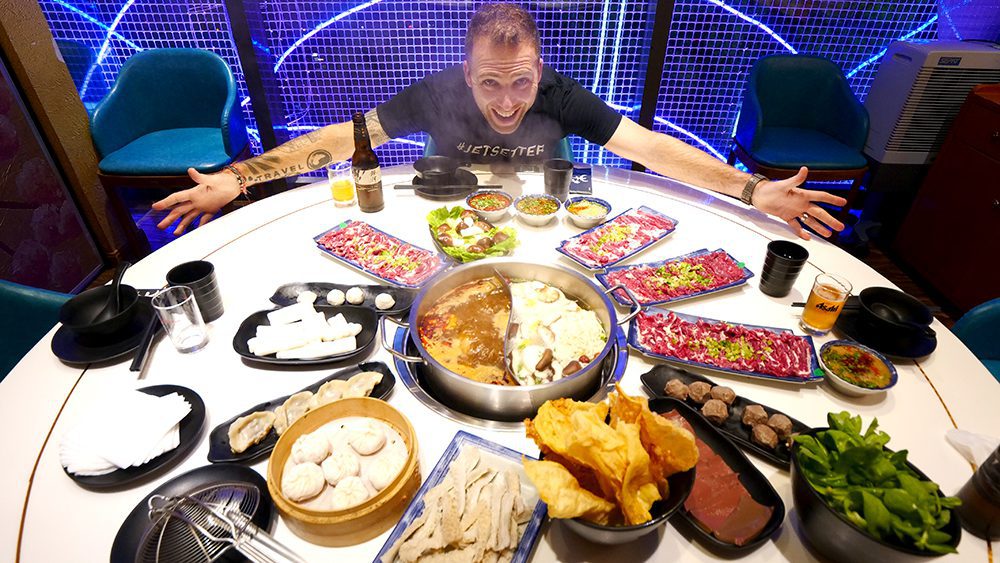
What makes The Holy Cow’s meat so delectable is that it’s the freshest meat imaginable. It has never been frozen, and you can taste it in the quality and feel it in the texture of the meat. Fresh is always best, and when you have a variety of tasty sauces to cook and dip the meat into, it’s a game-changer. You’ll never look at frozen meat the same way afterward!

From its awesome hot pots to its heavenly soup dumplings to its mouthwatering noodles, the food in Shanghai is about as diverse as they come. No matter what kind of food you like, you can find it in this incredible food city. By the time I left China, my taste buds had been blown away several times over by the magnificent flavors of Shanghai. The quality of the food and the sheer variety can’t be understated. If you’re a foodie, Shanghai has to be on your bucket list. Book a trip to Shanghai to get a taste of the city today!

NOTE: If you need to check the visa requirements of a particular country, click here. To apply for a visa, find up-to-date visa information for different countries, and calculate the cost of a particular visa, click here!
Counter
101 Countries • 1432 Cities
Kelly Yao says:
Most of these dishes are not Shanghainese, but they are definitely an awesome selection of Chinese food, and super authentic! As someone who grew up in China, I also recommend trying the pan-fried soup buns (there is a franchise called Xiaoyang Shengjian) in Shanghai, if you ever revisit the city.